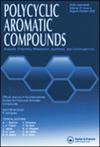Computational, Reactivity, Fukui Function, Molecular Docking, and Spectroscopic Studies of a Novel (E)-1-Benzyl-3-(2-(Pyrindin-2-yl)Hydrazono)Indolin-2-One
IF 2.4
3区 化学
Q2 CHEMISTRY, ORGANIC
引用次数: 0
Abstract
(E)-1-benzyl-3-(2-pyridine-2-yl)hydrazono)indolin-2-one (BPHI), an aromatic moiety, were subjected to a collection of theoretical studies with the help of the Gaussian 09, GaussView 6.0, and Multiwfn-3.8 packages of software. Its molecular geometry, bond angle, and bond length are computed theoretically. Vibrational assignments and PED values are calculated theoretically and were corroborated with experimental IR spectra to gain insight and knowledge about the structural details of BPHI. The theoretical determination of the electronic transitions along with photophysical properties for various mediums (viz., gas, acetonitrile, DMSO), including HOMO and LUMO energy gap are theoretically found from time-dependent—density functional theory (TD-DFT). Interpretation of the Fukui function helps in identifying the active sites in BPHI. To study the topology of BPHI, ELF maps (electron localization function) have been utilized. Alongside, detailed analyses of RDG (reduced density gradient) as well as LOL (localized orbital locator) are also carried out. Interactions pertaining to donor and acceptor moiety in BPHI are computed through natural bond analysis. MEP analysis is used to determine the bioactive site of BPHI. 4F5S crystal structure with respect to BSA protein was used for molecular docking with the help of the CB-dock software and docked results are visualized by Molegro molecular view software.
新型 (E)-1-Benzyl-3-(2-(Pyrindin-2-yl)Hydrazono)Indolin-2-One 的计算、反应性、福井函数、分子对接和光谱研究
(E)-1-苄基-3-(2-吡啶-2-基)肼基吲哚啉-2-酮(BPHI)是一种芳香族分子,在高斯 09、GaussView 6.0 和 Multiwfn-3.8 软件包的帮助下进行了一系列理论研究。对其分子几何形状、键角和键长进行了理论计算。振动赋值和 PED 值是通过理论计算得出的,并与实验红外光谱相互印证,从而深入了解了 BPHI 的结构细节。根据时间相关密度泛函理论(TD-DFT),从理论上确定了各种介质(即气体、乙腈和 DMSO)的电子跃迁和光物理性质,包括 HOMO 和 LUMO 能隙。对 Fukui 函数的解释有助于确定 BPHI 中的活性位点。为了研究 BPHI 的拓扑结构,还利用了 ELF 图(电子定位功能)。此外,还对 RDG(密度梯度降低)和 LOL(局部轨道定位器)进行了详细分析。通过自然键分析,计算了 BPHI 中供体和受体分子之间的相互作用。MEP 分析用于确定 BPHI 的生物活性位点。在 CB-dock 软件的帮助下,与 BSA 蛋白相关的 4F5S 晶体结构被用于分子对接,对接结果通过 Molegro molecular view 软件可视化。
本文章由计算机程序翻译,如有差异,请以英文原文为准。
求助全文
约1分钟内获得全文
求助全文
来源期刊

Polycyclic Aromatic Compounds
化学-有机化学
CiteScore
3.70
自引率
20.80%
发文量
412
审稿时长
3 months
期刊介绍:
The purpose of Polycyclic Aromatic Compounds is to provide an international and interdisciplinary forum for all aspects of research related to polycyclic aromatic compounds (PAC). Topics range from fundamental research in chemistry (including synthetic and theoretical chemistry) and physics (including astrophysics), as well as thermodynamics, spectroscopy, analytical methods, and biology to applied studies in environmental science, biochemistry, toxicology, and industry. Polycyclic Aromatic Compounds has an outstanding Editorial Board and offers a rapid and efficient peer review process, as well as a flexible open access policy.
 求助内容:
求助内容: 应助结果提醒方式:
应助结果提醒方式:


